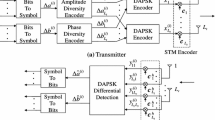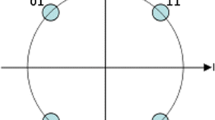Abstract
In this paper, we develop super-orthogonal space-time trellis codes (SOSTTCs) using differential binary phase-shift keying, quadriphase-shift keying and eight-phase shift keying for noncoherent communication systems with two transmit antennas without channel state information at the receiver. Based on a differential encoding scheme proposed by Tarokh and Jafarkhani, we propose a new decoding algorithm with reduced decoding complexity. To evaluate the performance of the SOSTTCs by way of computer simulations, a geometric two-ring channel model is employed throughout. The simulation results show that the new decoding algorithm has the same decoding performance compared with the traditional decoding strategy, while it reduces significantly the overall computing complexity. As expected the system performance depends greatly on the antenna spacing and on the angular spread of the incoming waves. For fair comparison, we also design SOSTTCs for coherent detection of the same complexity as those demonstrated for the noncoherent case. As in the case of classical single antenna transmission systems, the coherent scheme outperforms the differential one by approximately 3 dB for SOSTTCs as well.












Similar content being viewed by others
References
Abdi A, Barger JA, Kaveh M (2002) A parametric model for the distribution of the angle of arrival and the associated correlation function and power spectrum at the mobile station. IEEE Trans Veh Technol 51(3):425–434
Agrawal D, Richardson TL, Urbanke RL (2001) Multiple-antenna signal constellations for fading channels. IEEE Trans Inf Theory 47(6):2618–2626
Alamouti SM (1998) A simple transmit diversity technique for wireless communications. IEEE J Sel Areas Commun 16(8):1451–1458
Bahceci I, Duman TM (2004) Trellis-coded unitary space-time modulation. IEEE Trans Wirel Commun 3(6):2005–2012
Edbauer F (1989) Performance of interleaved trellis-coded differential 8-PSK modulation over fading channels. IEEE J Sel Areas Commun 7:1340–1346
Gutiérrez CA, Pätzold M (2007) Sum-of-sinusoids-based simulation of flat fading wireless propagation channels under non-isotropic scattering conditions. In: Proc 50th IEEE global communications conference, IEEE GLOBECOM 2007, Washington DC, USA, pp 3842–3846
Hochwald BM, Marzetta TL (2000) Unitary space-time modulation for multiple-antenna communications in Rayleigh flat fading. IEEE Trans Inf Theory 46:543–564
Hochwald BM, Marzetta TL, Richardson TJ, Sweldens W, Urbanke R (2000) Systematic design of unitary space-time constellations. IEEE Trans Inf Theory 46(6):1962–1973
Hughes BL (2000) Differential space-time modulation. IEEE Trans Inf Theory 46:2567–2578
Jafarkhani H, Seshadri N (2003) Super-orthogonal space-time trellis codes. IEEE Trans Inf Theory 49:937–950
Jafarkhani H, Tarokh V (2001) Multiple transmit antenna differential detection from generalized orthogonal designs. IEEE Trans Inf Theory 47(6):2626–2631
Ma Y, Pätzold M (2007) Wideband two-ring MIMO channel models for mobile-to-mobile communications. In: Proc 10th international symposium on Wireless Personal Multimedia Communications, WPMC 2007, Jaipur, India, pp 380–384
McLane PJ et al (1988) PSK and DPSK trellis codes for fast fading, shadowed mobile satellite communication channels. IEEE Trans Commun 36:1242–1246
Schlegel C, Costello DJ Jr (1989) Bandwidth efficient coding for fading channels: code construction and performance analysis. IEEE J Sel Areas Commun 7:1356–1368
Sterian CED, Enescu AA, Bǎnicǎ I (2007) Super-orthogonal space-time trellis codes with eight dimensional phase-shift keying signal constellations. Ann Télécommun 62(3/4):486–512
Sun Z, Tjhung TT (2003) On the performance analysis and design criteria for trellis coded unitary space-time modulation. IEEE Commun Lett 7(4):156–158
Sun Z, Tjhung TT (2004) Multiple-trellis-coded unitary space-time modulation in Rayleigh flat fading. IEEE Trans Wirel Commun 3(6):2335–2334
Tao M, Cheng RS (2003) Trellis-coded differential unitary space-time modulation over flat fading channels. IEEE Trans Commun 51(4):587–596
Tarokh V, Jafarkhani H (2000) A differential detection scheme for transmit diversity. IEEE J Sel Areas Commun 18(7):1169–1174
Tarokh V, Seshadri N, Calderbank AR (1998) Space-time codes for high data rate wireless communication: performance criterion and code construction. IEEE Trans Inf Theory 44(2):744–765
Ungerboeck G (1982) Channel coding with multilevel/phase signals. IEEE Trans Inf Theory IT-28:55–67
Wei LF (1984) Rotationally invariant convolutional channel coding with expanded signal space - part I: 180° and part II: nonlinear codes. IEEE J Sel Areas Commun 2:659–686
Wei LF (1993) Coded M-PSK with built-in time diversity for fading channels. IEEE Trans Inf Theory 39(6):1820–1839
Wu Y, Lau VKN, Pätzold M (2006) Constellation design for trellis-coded unitary space-time modulation systems. IEEE Trans Commun 54(11):1948–1959
Zhao W, Leus G, Giannakis GB (2004) Orthogonal design of unitary constellations for uncoded and trellis-coded noncoherent space-time systems. IEEE Trans Inf Theory 50(6):1319–1327
Zhu Y, Jafarkhani H (2006) Differential super-orthogonal space-time trellis codes. IEEE Trans Wirel Commun 5(12):3634–3643
Author information
Authors and Affiliations
Corresponding author
Rights and permissions
About this article
Cite this article
Sterian, C.E.D., Ma, Y., Pätzold, M. et al. New super-orthogonal space-time trellis codes using differential M-PSK for noncoherent mobile communication systems with two transmit antennas. Ann. Telecommun. 66, 257–273 (2011). https://doi.org/10.1007/s12243-010-0191-1
Received:
Accepted:
Published:
Issue Date:
DOI: https://doi.org/10.1007/s12243-010-0191-1




